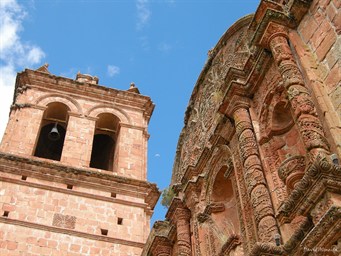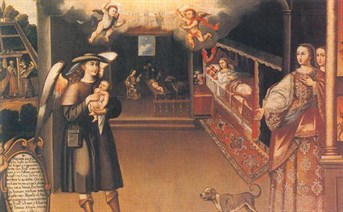Different versions of the Andean Baroque
 Baroque style, starting from 1630, gave birth to regionalization. The Baroque of Quito, for example, adopted local mestizo features of the people represented, with the frequent appearance of traditional indigenous costumes and Andean landscape, local flora and fauna, which replaced in this way, the European iconography present in the models imported from across the Atlantic. Even the use of techniques of carving and painting rooms accentuated this regionalization. A prime example of Baroque architecture is given by the Church of San Francisco (Saint Francis) of the Company of Jesus.
Baroque style, starting from 1630, gave birth to regionalization. The Baroque of Quito, for example, adopted local mestizo features of the people represented, with the frequent appearance of traditional indigenous costumes and Andean landscape, local flora and fauna, which replaced in this way, the European iconography present in the models imported from across the Atlantic. Even the use of techniques of carving and painting rooms accentuated this regionalization. A prime example of Baroque architecture is given by the Church of San Francisco (Saint Francis) of the Company of Jesus.
In the south, the Baroque of Arequipa and Potosí was characterized by a revival of pre-Hispanic themes. The decoration of the Cathedral of Puno integrated iconographic elements such as sirens, pumas, monkeys, tropical fruit. In the region of Lake Titicaca there are several areas with clusters of baroque temples. Juli, known as the “Little Rome of America”, the great Jesuit missionary center of the plateau, had four churches: San Juan de Letrán (Saint John Lateran), Santa Cruz de Jerusalén (The Holy Cross of Jerusalem), Nuestra Señora de la Asunción (Our Lady of the Assumption) and San Pedro Mártir (Saint Peter Martyr). The Dominicans had the sanctuary of Pomata where the cult of Our Lady of the Rosary is venerated in a shrine, the most famous in the region after that of Nuestra Señora de Copacabana (Our Lady of Copacabana), held by the Augustinians. The temple dedicated to Santiago Apóstol (Saint James the Apostle), in Pomata, marks the culmination of the mestizo style (photo 1).
Particularly important is the production in the area of Potosí, where a real school was formed. In the seventeenth century the mining area of Cerro Potosí, with the concentration of a large number of mining entrepreneurs, workers, dealers, craftsmen, all linked to the exploitation of silver deposits and induced activities, gave birth to the largest urban center of the whole of the Americas, with a population that exceeded 160,000 inhabitants. The magnificence of the churches and palaces still recalls the wealth of that period. Melchor Pérez de Holguín was formed in the school of Potosí. Born in Cochabamba, he was influenced by Zurbarán, especially in dealing with ascetical and mystical figures. Works such as the Triumph of the Church, the Final Judgement and the Entry of Archbishop Morcillo in Potosí testify to the splendor of the decorations and costumes.
 The so-called school of Cuzco which sprang up in the Incan city that continued to be an important political and cultural centre during Spanish rule, was characterized by the originality of the paintings that portray different characters, with special care in the representation of clothing and valuables. After the earthquake of 1650 that destroyed or damaged many buildings in the city, the decoration of churches and colleges was assigned to some local artists such as Diego Quispe Tito and Basilio Santa Cruz Poma Callao. The painting of these teachers and their students was characterized by a certain archaism, the use of gold ornaments, the elimination of realism which was replaced by a symbolic landscape, thus giving rise to an original sacred iconography that had its most authentic expression in the series of the archangels musketeers, angels wrapped in rich clothes, decorated in gold, wielding shotguns, as well as in the portraits of saints and madonnas adorned with gold and jewels. In this way, a part of the native mentality was able to fit into the western scheme, surviving in the contents expressed in artistic creation. (image: Basilio Santa Cruz Poma Callao, El nacimiento de San Francisco).
The so-called school of Cuzco which sprang up in the Incan city that continued to be an important political and cultural centre during Spanish rule, was characterized by the originality of the paintings that portray different characters, with special care in the representation of clothing and valuables. After the earthquake of 1650 that destroyed or damaged many buildings in the city, the decoration of churches and colleges was assigned to some local artists such as Diego Quispe Tito and Basilio Santa Cruz Poma Callao. The painting of these teachers and their students was characterized by a certain archaism, the use of gold ornaments, the elimination of realism which was replaced by a symbolic landscape, thus giving rise to an original sacred iconography that had its most authentic expression in the series of the archangels musketeers, angels wrapped in rich clothes, decorated in gold, wielding shotguns, as well as in the portraits of saints and madonnas adorned with gold and jewels. In this way, a part of the native mentality was able to fit into the western scheme, surviving in the contents expressed in artistic creation. (image: Basilio Santa Cruz Poma Callao, El nacimiento de San Francisco).
In summary, the mestizo style develops its own decoration, whose main themes incorporate mannerist and prehispanic motifs, local natural elements, pre-Renaissance Christian themes. The presence of local elements and classical motifs, through Mannerism, reflect the dominant view of nature and man in the Americas, initially considered idolatrous and, therefore, comparable to the pagans of the classical world, before the arrival of Christianity with its pervasive rationalization and conviction. The gaining of the upper hand of the indigenous artists in artistic production allows that elements of humanity, flora and fauna be a little present everywhere and express Andean reality. Moreover, these issues also spread through the minor arts: furniture, textiles, ceramics, jewellery, thus making the mestizo style widespread and enduring to the point that even today the consequences for local production are perceptible.
